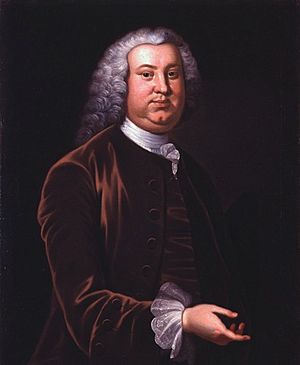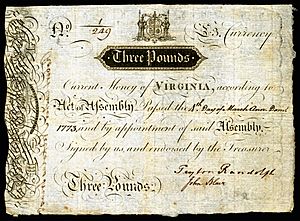Peyton Randolph facts for kids
Quick facts for kids
Peyton Randolph
|
|
|---|---|
 |
|
| 1st and 3rd President of the Continental Congress | |
| In office September 5, 1774 – October 22, 1774 |
|
| Preceded by | Office established |
| Succeeded by | Henry Middleton |
| In office May 10, 1775 – May 24, 1775 |
|
| Preceded by | Henry Middleton |
| Succeeded by | John Hancock |
| 33rd Speaker of the Virginia House of Burgesses | |
| In office 1766–1775 |
|
| Preceded by | John Robinson |
| Succeeded by | Office abolished |
| Personal details | |
| Born | September 10, 1721 Williamsburg, Colony of Virginia, British America |
| Died | October 22, 1775 (aged 54) Philadelphia, Province of Pennsylvania, British America |
| Resting place | Chapel of the College of William and Mary |
| Spouse | Elizabeth Harrison |
| Parents | Sir John Randolph Susanna Beverley |
| Alma mater | College of William and Mary |
| Signature | |

Peyton Randolph (born September 10, 1721 – died October 22, 1775) was an important leader from Virginia. He was a farmer and a public official. He served as the Speaker of Virginia's House of Burgesses, which was like their local government. He also led the Virginia Conventions, which were special meetings. Most famously, he was the first President of the Continental Congress, a group that helped lead the colonies toward independence.
Early Life and Education
Peyton Randolph was born in Williamsburg, Virginia. He came from a well-known and powerful family. His father was Sir John Randolph, and his mother was Susanna Beverley. His brother was also named John Randolph. Peyton was only 15 years old when his father passed away.
He went to the College of William and Mary. After that, he studied law in London, England, at a famous place called Middle Temple. He became a lawyer in 1743. He spent his adult life living in Williamsburg.
Political Career and Leadership
After studying law, Randolph returned to Williamsburg. The next year, he was chosen to be the Attorney General for the Virginia colony. This job meant he was the chief lawyer for the government.
He also served many times in the House of Burgesses, starting in 1748. The House of Burgesses was Virginia's elected assembly, like a parliament. In 1751, he faced a tricky situation because he had two important jobs. The new governor, Robert Dinwiddie, added a fee for land documents. The House of Burgesses strongly disagreed with this fee. They chose Peyton Randolph to go to London and argue their case to the King's officials. However, as Attorney General, he was supposed to support the governor's actions. Randolph went to London anyway, even though the governor didn't want him to. He was briefly replaced as Attorney General. When he returned, he got his job back, and the officials in London even suggested the governor remove the fee.
In 1765, Randolph had a disagreement with a new member of the House, Patrick Henry. This was about how to respond to the Stamp Act. This act was a new tax from Britain that made colonists pay for stamps on paper goods. Randolph wanted a more careful response. But Patrick Henry managed to pass some stronger resolutions against the act. This happened when many members were away, and Randolph was leading the meeting.
Randolph stopped being the Attorney General in 1766. This was because his fellow members in the House of Burgesses elected him as their Speaker. This happened after the previous powerful Speaker, John Robinson, died. As Speaker, Randolph was the leader of the House of Burgesses. He also helped manage the estate of the former Speaker.
As problems grew between Britain and the colonies, Randolph started to believe in independence. In 1769, the governor dissolved the House of Burgesses. This happened because the House spoke out against the Townshend Acts, which were more taxes from Britain. In 1773, Randolph led the Virginia committee of correspondence. These committees helped colonies share information and coordinate their actions.
In 1774, the next governor, Lord Dunmore, again dissolved the House of Burgesses. This was because they supported Boston after the Boston Port Act. This act closed Boston's port as punishment. After this, Randolph led meetings of the first Virginia Conventions. These were meetings of former House members who worked together to respond to the new British taxes.
On March 21, 1775, Randolph was president of the Second Virginia Convention in Richmond. This is where Patrick Henry gave his famous "give me liberty or give me death" speech. In April, Randolph talked with Lord Dunmore about gunpowder that was taken from the Williamsburg arsenal. This led to a confrontation between the governor's forces and Virginia's local militia.
The House of Burgesses met one last time in June 1775. This was to discuss a proposal from the British Prime Minister, Lord North. Randolph, who was also a delegate to the Continental Congress, returned to be Speaker. He pointed out that the proposal had been sent to each colony separately, trying to divide them. The House of Burgesses rejected the idea. Randolph was the very last Speaker of the House of Burgesses. Its role was later taken over by the Virginia Conventions and then the House of Delegates.
Randolph also led the Third Virginia Convention in July 1775. This group chose a Committee of Safety to act as the colony's government. This happened because Lord Dunmore had left the capital.
Virginia chose Randolph to be one of its delegates to the Continental Congress in Philadelphia in 1774 and 1775. The other delegates elected him as their president (leader) for both the First Continental Congress and the Second Continental Congress. The First Congress asked King George III to remove the Coercive Acts, which were harsh laws punishing Boston. The Second Congress sent the Olive Branch Petition, a final try for peace. However, Randolph became ill during both terms. He was replaced by Henry Middleton for a time. He was elected president again in May 1775 but left for Virginia four days later. John Hancock then became president.
Death and Lasting Impact
Peyton Randolph returned as a delegate for Virginia. He sadly passed away on October 22, 1775, in Philadelphia. He was having dinner with Thomas Jefferson when he had a sudden illness.
His body was brought back to Williamsburg. He was buried at the chapel of the College of William and Mary. Some people think Randolph was the first President of the United States. This is because the Continental Congress took on government duties for all the colonies.
The Continental Congress honored Randolph by naming one of the first naval ships the USS Randolph. They also named a fort where the Ohio and Kanawha Rivers meet Fort Randolph.
Several places were named after him, including Randolph County, North Carolina, Randolph, Massachusetts, and Randolph County, Indiana.
During World War II, a large aircraft carrier, the USS Randolph (CV-15), was also named in his honor.
His home in Colonial Williamsburg, the Peyton Randolph House, was recognized as an important historical site in 1970.
See also
 In Spanish: Peyton Randolph para niños
In Spanish: Peyton Randolph para niños

